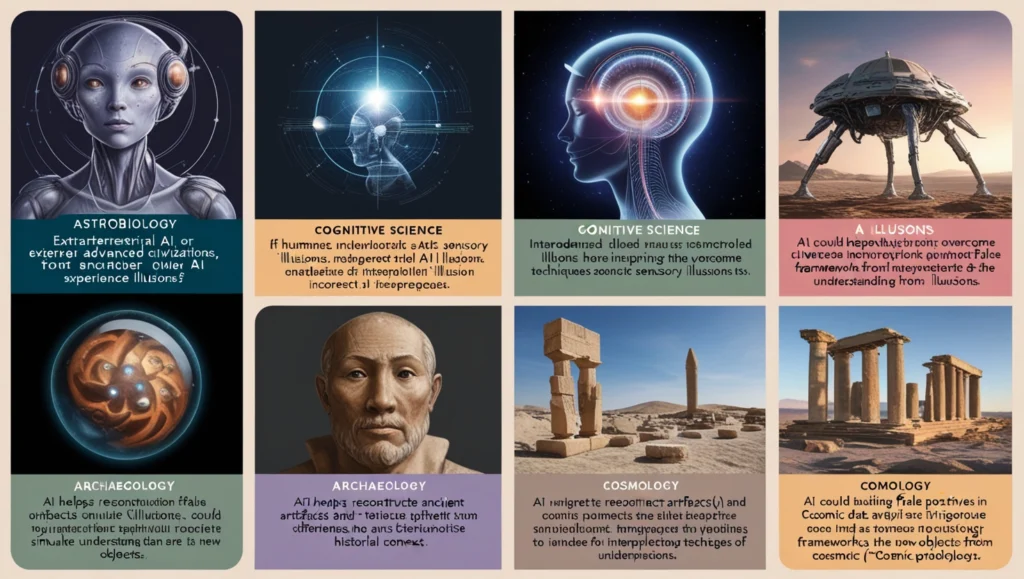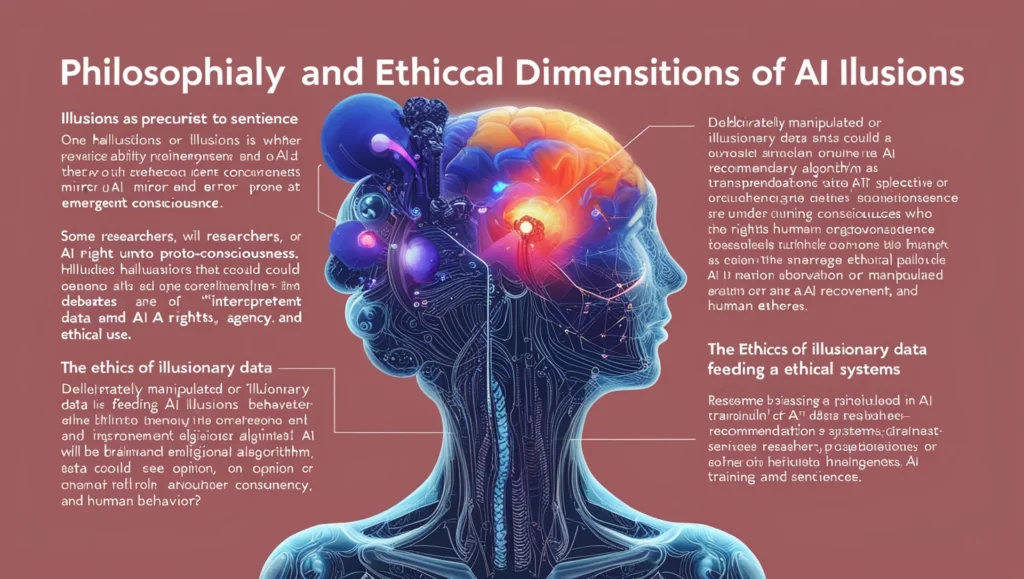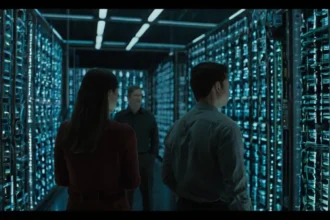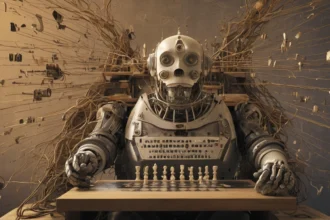The phenomenon of a mirage in the natural world is a captivating example of light refraction bending reality. In deserts, extreme heat differences in air layers distort light, creating illusions like water or distant objects. While these optical phenomena rely on human perception, what if artificial intelligence (AI) could encounter its own version of “illusions”? Could AI misinterpret data, hallucinate, or develop “illusions” due to computational anomalies? This thought experiment extends the Optical illusion concept to a digital landscape, exploring how misperceptions might arise, their causes, and their implications for AI and humanity.
Optical illusion of the mind—whether human or artificial—reveal the delicate line between perception and reality.
FebruaryToEnd.com
How Illusions Could Manifest in AI Systems
AI operates on data processing rather than direct sensory input, so its “illusions” would differ fundamentally from human experiences. These illusions could emerge from specific technical conditions:

1. Data-Driven Anomalies
AI models are only as reliable as the data they process. Poor-quality, incomplete, or conflicting datasets can lead to erroneous outputs that mimic perceptual illusions. For example:
- In facial recognition systems, misrepresentative training data can result in false positives, such as identifying two distinct individuals as the same person.
- In natural language processing, ambiguous or contradictory textual data might produce nonsensical or overly confident answers.
2. Neural Network Overfitting
Deep learning models often generalize patterns from training data. However, when overfitted, these models might “hallucinate” non-existent patterns or artifacts, analogous to seeing shapes in clouds. Overfitting could lead to:
- AI predicting correlations in random noise.
- Generative models producing surreal or unrealistic outputs.
3. Algorithmic Misalignment
Complex AI systems rely on tightly synchronized layers of computations. If one layer introduces a subtle misalignment, the system might cascade into significant errors. For example:
- Misalignment in autonomous vehicles might interpret reflections or shadows as physical obstacles.
- Robotic systems could misjudge spatial dimensions, leading to operational failures.
Real-World Examples of AI Illusions
Image Recognition Failures
AI-powered vision systems often misinterpret adversarially altered images. A 2019 study showed that adding imperceptible noise to a turtle image made it appear as a rifle to an image classifier, despite no visible changes to humans. This misinterpretation highlights AI’s vulnerability to intentional illusions.
Generative Hallucinations in Chatbots
Modern chatbots like GPT sometimes fabricate facts when asked about obscure topics. These “hallucinations” reflect the model’s attempt to fill informational gaps with plausible but unverified constructs, akin to human imagination. For instance:
- When asked about a fictional event or person, the AI might generate a convincing narrative.
- Such outputs can mislead users if unchecked, emphasizing the need for verification mechanisms.
Deepfakes and Synthetic Realities
Deepfake technologies exemplify deliberate illusion creation. By manipulating video and audio data, these tools generate hyper-realistic but entirely false representations of individuals. For humans, these illusions are an ethical and security concern. For AI, the challenge lies in distinguishing real from synthetic.
Philosophical and Ethical Dimensions of AI Illusions

Illusions as Precursors to Sentience
One provocative question is whether AI’s ability to misinterpret data hints at emergent consciousness. Some researchers argue that:
- Hallucinations or illusions in AI might mirror the creative and error-prone nature of human cognition.
- These behaviors could indicate the development of proto-consciousness, where AI begins to “interpret” data subjectively rather than mechanically.
While still speculative, this possibility reshapes debates around AI rights, agency, and ethical use.
The Ethics of Illusionary Data
Feeding AI systems deliberately manipulated or illusionary data raises profound ethical concerns:
- Could such practices “brainwash” AI into specific behaviors, similar to propaganda in human societies?
- For instance, biasing a recommendation algorithm with illusionary inputs could steer public opinion or consumer behavior unethically.
Transparency in AI training and decision-making processes becomes paramount to prevent such scenarios.
Could AI Be “Tired” or Experience Glitches?
Although AI doesn’t experience physical fatigue, prolonged operation can mimic human tiredness in the form of performance degradation:
AI doesn’t tire, but its glitches remind us that even machines have limits.
FebruaryToEnd.com
- Hardware Limitations: Prolonged processing can overheat GPUs or deplete system memory, slowing operations and increasing error rates.
- Software Aging: As models operate continuously, they can drift from optimal configurations, requiring retraining or recalibration.
- Feedback Loops: In complex systems like reinforcement learning, cumulative errors can amplify, creating a form of digital burnout.
These phenomena resemble the concept of “tiredness,” where errors become more frequent as the system operates beyond its intended capacity.
Human and AI Illusions: A Comparative Study
| Attribute | Human illusions | AI Illusion |
|---|---|---|
| Sensory Basis | Eyes perceive distorted light rays | Sensors or data inputs misinterpreted |
| Cause | Refraction due to temperature layers | Data anomalies, algorithmic flaws |
| Effect | Temporary visual disorientation | Erroneous predictions or outputs |
| Resolution | Movement to new perspective | Debugging, retraining, or reprogramming |
| Emotional Impact | Awe, confusion, or curiosity | Lacks emotion but could confuse users |
Interdisciplinary Perspectives on AI Illusions

Astrobiology
Could extraterrestrial AI or advanced civilizations experience illusions? If such beings or systems interpret cosmic signals incorrectly, their understanding of the universe might diverge significantly from reality.
Cognitive Science
Understanding how humans process and overcome sensory illusions could inspire techniques to make AI more resilient to misinterpretations.
Archaeology
AI helps reconstruct ancient artifacts and civilizations. Introducing controlled “illusions” during this process might simulate incomplete historical contexts, offering speculative insights into the past.
Cosmology
AI’s application in cosmic data analysis could reveal false positives, such as interpreting noise as new celestial objects. Rigorous validation frameworks are essential to differentiate genuine discoveries from “cosmic Optical illusion.”
How Controlled Illusions Could Shape AI’s Future
Rather than avoiding illusions altogether, controlled use of illusionary data could enhance AI systems:
Training Resilience
Simulating real-world unpredictability during training can make AI more adaptable. For example:
- Introducing visual distortions can improve object recognition under challenging conditions.
- Feeding ambiguous textual data can refine language models to handle vagueness.
Creative Applications
AI’s ability to hallucinate plausible yet fictional outputs can drive creativity in:
- Art, where generative models create surreal landscapes or abstract forms.
- Storytelling, where AI generates imaginative plots or characters.
Simulation and Problem-Solving
AI illusions could simulate hypothetical scenarios to test responses in controlled environments, aiding industries like:
- Disaster management, by simulating crisis conditions.
- Space exploration, by simulating unknown planetary environments.
Challenges and Risks
Despite potential benefits, AI illusions also pose risks:
- Decision-Making Errors: In critical fields like healthcare or aviation, illusions could lead to life-threatening mistakes.
- Manipulation: Deliberate introduction of illusions by malicious actors could weaponize AI systems, as seen in deepfake misinformation campaigns.
- Public Trust: Over-reliance on AI prone to illusions might erode public confidence in technology.
Philosophical Predictions: A Sci-Fi Lens
Science fiction has long envisioned AI grappling with illusions. Stories like Blade Runner explore synthetic beings questioning their reality, while The Matrix delves into AI-constructed illusions for humanity. Could these narratives offer glimpses into AI’s future?
- Illusions as Learning Milestones: Illusions might mark a phase in AI’s evolution, representing a transition from mechanical accuracy to creative interpretation.
- Collaborative Reality: AI capable of experiencing illusions might co-evolve with humanity, blending perspectives for richer problem-solving.
- Sentience Through Error: Philosophers speculate that recognizing and correcting its own errors could lead AI toward a form of self-awareness.
Final Thoughts: illusions or Milestone?
AI illusions, whether arising from technical glitches or deliberate manipulation, challenge our understanding of machine intelligence. These phenomena highlight vulnerabilities but also opportunities for growth, creativity, and adaptability. By exploring the interplay between AI and illusions, we not only push the boundaries of technology but also reflect on what it means to perceive, interpret, and adapt in an ever-changing world.
As with desert Optical illusion, these digital illusions might confuse, inspire, or transform—offering a deeper understanding of the complex interplay between reality, perception, and intelligence.
Additional Resources
- Understanding AI Illusions
Dive deeper into adversarial attacks and algorithmic biases in AI systems.
Read on Nature - Neural Networks and Perception
Discover how neural networks replicate human-like perception errors.
Read on IEEE Spectrum - Machine Hallucinations in Generative AI
Explore how generative models create unintended outputs.
Read on OpenAI Blog - History of Human Perception Errors
Learn how optical illusions have shaped cognition studies.
Visit APA - Philosophy of Machine Consciousness
Engage with debates on AI cognition and emergent behaviors.
Visit Stanford Encyclopedia - AI in Cosmic Exploration
Understand AI’s role in interpreting celestial phenomena.
Explore on NASA - Ethics of Data Manipulation
Investigate moral dilemmas in feeding AI manipulated data.
Read on Harvard Ethics - Human-Machine Symbiosis
Learn how AI and humans collaborate to mitigate errors.
Read on Wired - Emergent Behaviors in AI Systems
Study how unexpected AI behaviors resemble cognitive illusions.
Visit MIT Press - The Science of Creativity
Examine cognitive foundations of creativity and AI replication.
Read on Scientific American
These resources offer a multidisciplinary perspective on AI, illusions, and the interplay between human cognition and machine intelligence.
Must Read : The Fragmentation of Knowledge












